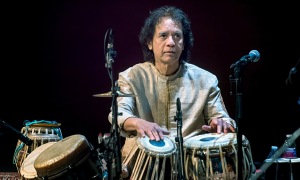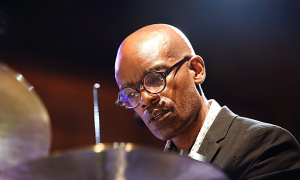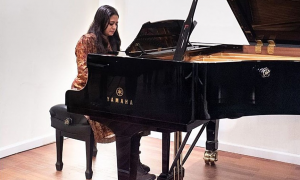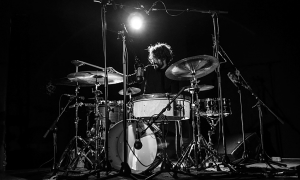Home » Jazz Articles » Under the Radar » Culture Clubs: A History of the U.S. Jazz Clubs, Part II: New York
Culture Clubs: A History of the U.S. Jazz Clubs, Part II: New York

New York
If any venue symbolized the Jazz Age, it was The Cotton Club. It began life in 1920 as the Club Deluxe, a Harlem supper club at 142nd Street and Lenox Avenue. Run by boxer Jack Johnson, the club was taken over by a paroled mobster, Owney Madden, in 1923 and the name changed to The Cotton Club. Johnson remained the manager but the club essentially became a front for selling liquor during prohibition. The club operated from 1923 to 1935 at the Harlem location, moving to midtown Manhattan in 1936 and then closing in 1940. Despite featuring the most popular black artists of the era, The Cotton Club served a "white-only" clientele, was decorated in blatantly racist themes, and performers and patrons were strictly segregated. Writer Langston Hughes described the setting as "a Jim Crow club for gangsters and moneyed whites..." Despite the oppressive working conditions, the club provided beneficial exposure for the musicians (often through affiliated radio broadcasts) as well as a relatively high pay rate. Among the performers were Cab Calloway, Fletcher Henderson, Billie Holiday, Jimmie Lunceford, Louis Armstrong, Count Basie, Fats Waller and Duke Ellington. It was Ellington's stature and influence that eventually convinced club management to relax—but not eliminate—its racial admission restrictions.
In polar opposition to the exclusive and glitzy Cotton Club was Café Society. Located in the Sheridan Square section of Greenwich Village, this "neighborhood" was a small triangle plot at the intersection of Washington Place, West 4th Street, and Barrow Street. A microcosm of an ideal culture, Café Society was the first jazz club to pursue integrated audiences, going as far as providing preferential seating to patrons of color while openly welcoming celebrities and members of the privileged class. The club was strictly about the music; there was no dancing or audience socializing during performances. Billie Holiday, though she played the Cotton Club as well, made her reputation at Café Society where she sang from the club's first day in business. Singers were the specialty of the club with Hazel Scott, Big Joe Turner, Lena Horne and Sarah Vaughan all performing on its small stage.
Café Society was run by Barney Josephson who had an affinity for left-wing causes and privately hosted related events in support of those efforts. Those undertakings led to his brother being called to testify before the House Committee on Un-American Activities in 1947. The committee was a precursor to the Joseph McCarthy "red scare" hearings of the 1950s, convened to investigate any citizen suspected of having Communist ties. The allegations against Josephson were fueled by a popular and ruthless New York gossip columnist, Walter Winchell, whose unsubstantiated claims and negative coverage of Josephson badly damaged business at Café Society. The following year, the club closed.
Harlem's Lenox Lounge opened in 1939 at 125th Street and Lenox Avenue (more recently designated as Malcolm X Blvd.). Established by Ralph Greco, the venue was later taken over by his nephew Dominic Greco who started working at the club as a seventeen-year-old bartender. Jazz greats such as Dizzy Gillespie, Miles Davis, John Coltrane and Billie Holiday all played there and the club's notable clientele included Langston Hughes, Malcolm X and James Baldwin.
The Lounge was laid out with two distinct functions in mind. The Zebra Room—famous for its Art Deco style—was the performance space and the adjacent room was a bar. From the financially strapped 1970s until the end of the 1990s, the bar was in a state of perpetual decline. In 1988 the lounge was purchased by promoter and entrepreneur Alvin Reid. The Richmond, Virginia native grew up in Harlem and was a member of the New York City Transit Police until his retirement in 1980. Using his retirement savings he bought the lounge to revive the dwindling presence of jazz venues in Harlem. From Fall 1999 to Spring 2000, Reid spent over one half-million dollars to restore the original Art Deco interior of the club. It was the only period of time the Lenox Lounge was closed in the preceding sixty years.
In the 1990s and early 2000s, the lounge was featured in scenes from a number of television programs, movies and music videos. The Zagat Survey Nightlife Guide and New York Magazine both rated it as a top destination. In 2012, the property's landlord doubled the rent and Reid, unable to manage the increase, closed the Lenox Lounge after seventy-three years. Two years later, a noted restaurateur, Richard Notar announced that he would reopen the club, and Reid, with another business partner, revealed similar plans a short time later. Notar, who owns Nobu—the most widely recognized chain of Japanese restaurants in the world—had previously attempted to revive another Harlem landmark jazz club, Minton's. Neither endeavor succeeded, though Minton's did later reopen under different ownership. Reid failed to revive the Lenox Lounge as well, facing prohibitive financial and legal challenges.
Gordon Polatnick runs Big Apple Jazz Tours, with stops in both uptown and downtown New York. On a rare quiet night during the 2015 holiday season, when Polatnick wasn't guiding a group through his maze of club connections, he accompanied us to the renowned Minton's Playhouse, listed on the U.S. National Register of Historic Places. On its face, the Second Renaissance Revival architecture retains the class of the club's glory days. Once inside, the Minton's of the 2000s, bears little resemblance to the club opened by Henry Minton in 1938 on 118th Street. Minton was a tenor saxophonist and a savvy businessman; he provided a safe space for jam sessions that would normally result in heavy union fines against participating musicians.
In 1940, Teddy Hill was hired to manage Minton's. Hill had a well-established career as a big band leader, drummer and multi-reed player with twenty-five sides recorded. His big band—at various points in time—had employed Roy Eldridge, Bill Coleman, Frankie Newton and Dizzy Gillespie. Hill worked regularly as the NBC radio network big band leader before taking on the Minton's role. Under his management, Minton's became the pre-52nd Street incubator of the bebop movement and the birthplace of modern jazz. The Minton's jam sessions drew in some of the most prominent artists of the era, including Gillespie, Ben Webster, Don Byas, Lester Young, Charlie Parker, Thelonious Monk, Kenny Clarke and Charlie Christian. The jam sessions inspired Monday Celebrity Nights, an event co-sponsored by the owners of the Apollo Theater. Session spots at Minton's became so intensely competitive that the process of securing a seat on the stage became more exclusionary and less democratic. Minton's closed for renovations in the summer of 2017 with a scheduled re-opening in the fall.
Bebop made its name in the clubs that densely populated the 52nd Street area. The Royal Roost has a ten-year run beginning in 1946 and featured the new style of jazz with names like Charlie Parker, Dizzy Gillespie, Tadd Dameron, Dexter Gordon, Fats Navarro and Max Roach. The 1950s saw the birth of The Five Spot and revolutionaries such as Thelonious Monk, Charles Mingus, Miles Davis and later, John Coltrane, Cecil Taylor, Charlie Haden and Ornette Coleman. In 1957, in a bleak and isolated section of West Village, a gritty bar was converted to The Half Note. Primarily dedicated to swing, the club was also host to more cutting edge performers of that era. Coltrane and Mingus played here as well, and more straight-ahead acts such as Wes Montgomery, Herbie Mann and Cannonball Adderley took to a stage that was slapped together from the remains of wooden shipping pallets.
The original Birdland opened in 1949, on Broadway, near 52nd Street featuring Bird himself as a headliner. Despite the club's principle owners capitalizing on Charlie Parker's trademark nickname, he didn't play there often but it was not due to Parker's well-known drug addiction. Owners Irving Levy, Morris Levy, and Oscar Goodstein simply didn't want to pay Parker the rate he was commanding at the height of his popularity. In addition to Parker, Gillespie, Monk, Miles, Coltrane, Bud Powell, Stan Getz, Lester Young, and many other familiar names were regularly booked. In its first five years, Birdland drew almost one and a half million paying customers. The club declared bankruptcy in 1964 and closed, reopening with a new owner more than twenty years later in Harlem. Ten years later, in 1986, the club again relocated, this time to its present location at 315 West 44th Street. Among those who have performed at the current site are Michael Brecker, Pat Metheny, Diana Krall and Dave Holland. The club also features a house band -The Birdland Big Band.
Clubs with the type of forward-thinking agenda practiced by The Half Note, sixty years before, exist in greater abundance today. One New York example is The Jazz Gallery which views itself as a pivotal player in global jazz. Founded in 1995 by a small group that includes Roy Hargrove, the international flavor was evident on a night in April, 2015 when I had the opportunity to see Rob Mazurek's Sao Paulo Underground and Black Cube SP perform. That collective encompassed artists from the U.S., Switzerland and Brazil, speaking not only to an international scope but also to the club's mission of bringing innovative musicians to the forefront.
In New York, the number of dedicated jazz clubs is more than twice that of the next largest market, Chicago. There are a host of current "high-end" clubs in Manhattan and most have been well-documented by virtue of booking big names and offering more upscale ambience. The Blue Note, a franchise with a presence on four continents is likely the best known of this group. Dizzy's Club Coca-Cola (Jazz at Lincoln Center) benefits from the star power of Gillespie's name and Wynton Marsalis, as the Artistic Director of JALC. Dizzy's is just one component of a broad array of musical and educational programs and features that reside under the JALC umbrella. The Jazz Standard is one of the more recent—and more posh—clubs in Manhattan. The Mingus Orchestra is the unofficial house band and the club is noted for both top name extended engagements and on-site, live recordings. Most notable in both categories is the Maria Schneider Jazz Orchestra with additional "Live at the Jazz Standard" releases coming from the Dave Douglas Quintet, David Gilmore, Fred Hersch and others.
A Dichotomy of Settings
From many of the higher elevations in Tarrytown, New York, the skyline of Manhattan—a thirty minute drive away—is a clearly visible picture postcard from where the Hudson River spans more than three miles. The Tarrytown Music Hall is one of the oldest theaters in U.S. and continues to be a solidly booked venue. The village of eleven thousand people is something of a U.S. miniature. There are two bona fide castles, Gothic Revival mansions like Lyndhurst, and Sunnyside, estates such as those that once belonged to John D. Rockefeller, Jay Gould and Washington Irving—and old Victorian mansions, all sharing a land mass of less than three square miles with the middle class and a smaller portion of the population, living under the poverty line. The old-world character that defines some parts of the town, carries over to the narrow roadway leading to 1 Dixon Lane. The atmosphere shifts again, on arriving at the Jazz Forum Club.
I first met Mark Morganelli, the Executive Director of the Jazz Forum Arts, in 2014 at one of his outdoor, summer Sunset Jazz at Lyndhurst shows. It's one of several venues in the NYC suburbs where he hosts these events. Because this location overlooks a wide expanse of the river, it is a prominent seasonal destination for jazz and music fans in general. I met with Morganelli at his new club, days after its opening in mid-2017. His history of involvement in jazz reflects his life's work. While still in college he directed the Bucknell Jazz Ensemble, booking their concerts and tours and taking them to the Montreux Jazz Festival in 1976. As a twenty year old he produced coffeehouse shows featuring contemporary music, avant-garde, a bit of classical folk jazz, and photography exhibits. He has produced about forty recordings.
Morganelli started playing the trumpet at nine and remains active. He trades off with the rounder sound of flugelhorn, especially when playing the Brazilian music he favors. Morganelli has recorded four albums as a leader, the most recent, My Romance (Jazz Forum Records, 2004), a quintet that includes tenor saxophonist Houston Person. The standards collection displays Morganelli's hard bop, swing and lyrical styles in one setting. A skilled improviser and soloist, he can now be heard playing at his home base from time to time.
The connection between the Jazz Forum Club and the Jazz Forum Arts organization is inextricable. The club is run through the auspices of the forum—a non-profit started by Morganelli and his wife, Ellen Prior, in 1985—and is further sponsored by Montefiore Hospital. Board members have included well-known jazz personalities such as Wynton Marsalis, Dizzy Gillespie and Gary Giddins. Their mission is to bring top quality arts programs to the public, including thirty-four free concerts this past summer sponsored by New York Presbyterian Hospital. These are intended to be welcoming community events for people who are experiencing jazz music for the first time, and Morganelli hopes to convert some of those attendees into paying customers of the club. Morganelli makes an important distinction in what qualifies as a genuine jazz club venue, saying "There are restaurants with jazz music and then there are jazz clubs that offer food. We are a jazz club." In fact, Morganelli is proud of the fine wine selection that he and his wife have extensively researched for the club, but food choices are limited to hors d'oeuvre.
Jazz Forum Club reserves Fridays and Saturdays for headline jazz artists, while Sundays are billed as "Brazilian Music Sundays." The upcoming season will include performances from Mark Egan, Danny Gottlieb, the previously mentioned Houston Person, and Jason Marsalis. Other special events on the calendar include birthday celebrations with Lee Konitz and David Amram.
About thirty minutes south, a different club could be in an alternate universe when compared to the Jazz Forum Club. Late in 2015, between Christmas and the New Year, we stopped into Paris Blues at 2021 Adam Clayton Powell, Jr., Blvd. (7th Ave.) in Harlem. In the narrow entrance there is a bar to the right and Samuel Hargress, Jr., to the left. Less than a year from his eightieth birthday, age didn't keep him from bouncing off the bench, shaking hands and offering the fried chicken, black beans and rice, warming on a hot plate. In one of his distinctive three-piece suits and a wide-brim fedora, Hargress is as much a landmark as his club. Paris Blues is considered a "jazz dive," the oldest, and only remaining venue of that type in New York. The club's name is hand painted in one-foot blue letters on a white sheet, hung across the back of the stage and a visitor is as likely to see a jazz legend such as Frank Lacey taking in a show as they are to see him on stage.
Hargress had served in the U.S. Army as part of their military police unit in various European locations, including Paris. The club's name was derived from Hargress' experiences with the personal respect shown to black people in Paris, in comparison to the discrimination in his birthplace, Demopolis, Alabama. From those experiences, he derived the name of the club that he first opened in 1969. The failing economy, drugs and crime made the odds of success, at that time and place in New York City history, slim at best. But Hargress was determined, helping to set up a civilian neighborhood patrol to keep the club, and nearby streets, safe.
On this late night, almost forty-five years later, the crowd is small -not that Paris Blues could hold a large crowd. The stage is compact and sits flush with the seating area, much of which is occupied by the bar. We are listening to the Antoine Dowdell Group, regular performers at the club, and like much of the entertainment here, pianist Dowdell and his drummer Dameyum Henry are products of Harlem. But in the quirky world of Paris Blues, the group skews toward Japan, with bassist Kenji Tokunaga, guitarist Yoshiki Miura and saxophonist Ryoju Fukushiro all being natives of that country. Another group, Melvin Vines & The Harlem Jazz Machine, have also occupied numerous dates on the club's calendar for a number of years. Paris Blues has an unforced way of feeling like home; it is welcoming and fun and the music is outstanding.
Duke Ellington at The Cotton Club (RCA Camden, 1959)
 Duke Ellington's orchestra was hired as the house band for the Cotton Club in 1927, and though Cab Calloway and his orchestra assumed that role in 1931, Ellington continued to perform at the venue. The performances on ...at The Cotton Club were culled from shows in 1937 and 1938. Ellington's formats varied from solo piano through orchestra and many of the pieces on the album were those that were commercially popular at the time.
Duke Ellington's orchestra was hired as the house band for the Cotton Club in 1927, and though Cab Calloway and his orchestra assumed that role in 1931, Ellington continued to perform at the venue. The performances on ...at The Cotton Club were culled from shows in 1937 and 1938. Ellington's formats varied from solo piano through orchestra and many of the pieces on the album were those that were commercially popular at the time. "In a Sentimental Mood," "Mood Indigo," "East St. Louis Toodle-Oo," "If Dreams Come True," "You Went to My Head" and "Solitude" are among the classic compositions represented here. Lesser known pieces such as "Harmony in Harlem," "Scrontch," "Downtown Uproar," "Carnival in Caroline" and "Riding on a Blue Note" occupy equal space. Ellington's orchestra including many of the top name artists of the time including Johnny Hodges, Cootie Williams, Harry Carney and Ivie Anderson, who took on many of the vocals.
Keith Jarrett at the Blue Note (ECM, 1995)
 With his Standards Trio of bassist Gary Peacock and drummer Jack DeJohnette, Keith Jarrett released this six-CD box set documenting one set per disc from a three-night engagement at the Blue Note in the spring of 1994. It was Jarrett's return to New York following a ten-plus year absence. The tenth release from a group that eventually compiled twenty recordings, the Blue Note sessions were also offered commercially as a single CD release featuring the first of the sets.
With his Standards Trio of bassist Gary Peacock and drummer Jack DeJohnette, Keith Jarrett released this six-CD box set documenting one set per disc from a three-night engagement at the Blue Note in the spring of 1994. It was Jarrett's return to New York following a ten-plus year absence. The tenth release from a group that eventually compiled twenty recordings, the Blue Note sessions were also offered commercially as a single CD release featuring the first of the sets. Primarily performing a collection of standards, both well-known and obscure, Jarrett's trio may have been justifiably linked with the Bill Evans model but their buoyant melodies and bare suggestions of the same are enhanced with Jarrett's extended improvisations. He leaves notes hanging in the ether and when they evaporate, he seems to savor the silence for just long enough. For all Jarrett's demands of his live audiences, he rewards them with unequalled showmanship.
Live at the Jazz Standard—Days of Wine and Roses (ArtistShare, 2000)
 Maria Schneider's always expressive orchestra takes on more power and swing in a live setting. With a group largely intact from her Coming About (Enja, 1996) release, there is an easiness in the working relationship between Schneider and the group. The quintessentially proficient ensemble takes their cue from Schneider's tightly punctuated conducting style while strategically placed solos leave plenty of space for restrained improvisations.
Maria Schneider's always expressive orchestra takes on more power and swing in a live setting. With a group largely intact from her Coming About (Enja, 1996) release, there is an easiness in the working relationship between Schneider and the group. The quintessentially proficient ensemble takes their cue from Schneider's tightly punctuated conducting style while strategically placed solos leave plenty of space for restrained improvisations. A multiple "Best Composer" winner in annual polls, Schneider's live recording reaches back to older sources for much of Live at the Jazz Standard—Days of Wine and Roses. A mix of standards and original music, Schneider culls material from as far back as twenty years for her own compositions. Her "Lately" was written more than a decade before the recording; it had been earmarked for Mel Lewis but remained on the back burner. Schneider's "Bird Count," "Last Season" and "My Ideal" are dispersed among standards such as "That Old Black Magic," "Over the Rainbow" and the title track. Saxophonists Tim Ries (tenor and soprano), Rich Perry (tenor) and Scott Robinson (baritone) have excellent solos throughout as does pianist Frank Kimbrough.
New Orleans, Chicago and New York were the hubs in the development of jazz in the U.S. but there were many spokes that sped the dissemination of the genre. In Part III of Culture Clubs we look at Kansas City, Los Angeles, Philadelphia and Boston.
< Previous
Horizontal Dialogues
Next >
Cuban Nocturne
Comments
Tags
Under the Radar
Karl Ackermann
Cab Calloway
Fletcher Henderson
Billie Holiday
Jimmie Lunceford
Louis Armstrong
Count Basie
Fats Waller
duke ellington
Big Joe Turner
Lena Horne
Sarah Vaughan
Dizzy Gillespie
Miles Davis
John Coltrane
Teddy Hill
Roy Eldridge
Bill Coleman
Frankie Newton
ben webster
Don Byas
Lester Young
Charlie Parker
Thelonious Monk
Kenny Clarke
Charlie Christian
Tadd Dameron
Dexter Gordon
Fats Navarro
Max Roach
Charles Mingus
Cecil Taylor
Charlie Haden
Ornette Coleman
Wes Montgomery
Herbie Mann
Bud Powell
Stan Getz
Michael Brecker
pat metheny
Diana Krall
Dave Holland
Roy Hargrove
Rob Mazurek
Sao Paulo Underground
The Mingus Orchestra
Maria Schneider
Dave Douglas
David Gilmore
Fred Hersch
Mark Morganelli
Houston Person
Mark Egan
Danny Gottlieb
Jason Marsalis
Lee Konitz
David Amram
Frank Lacey
Gary Peacock
Jack DeJohnette
Bill Evans
Mel Lewis
Tim Ries
Rich Perry
Scott Robinson
Frank Kimbrough
For the Love of Jazz
 All About Jazz has been a pillar of jazz since 1995, championing it as an art form and, more importantly, supporting the musicians who create it. Our enduring commitment has made "AAJ" one of the most culturally important websites of its kind, read by hundreds of thousands of fans, musicians and industry figures every month.
All About Jazz has been a pillar of jazz since 1995, championing it as an art form and, more importantly, supporting the musicians who create it. Our enduring commitment has made "AAJ" one of the most culturally important websites of its kind, read by hundreds of thousands of fans, musicians and industry figures every month.























